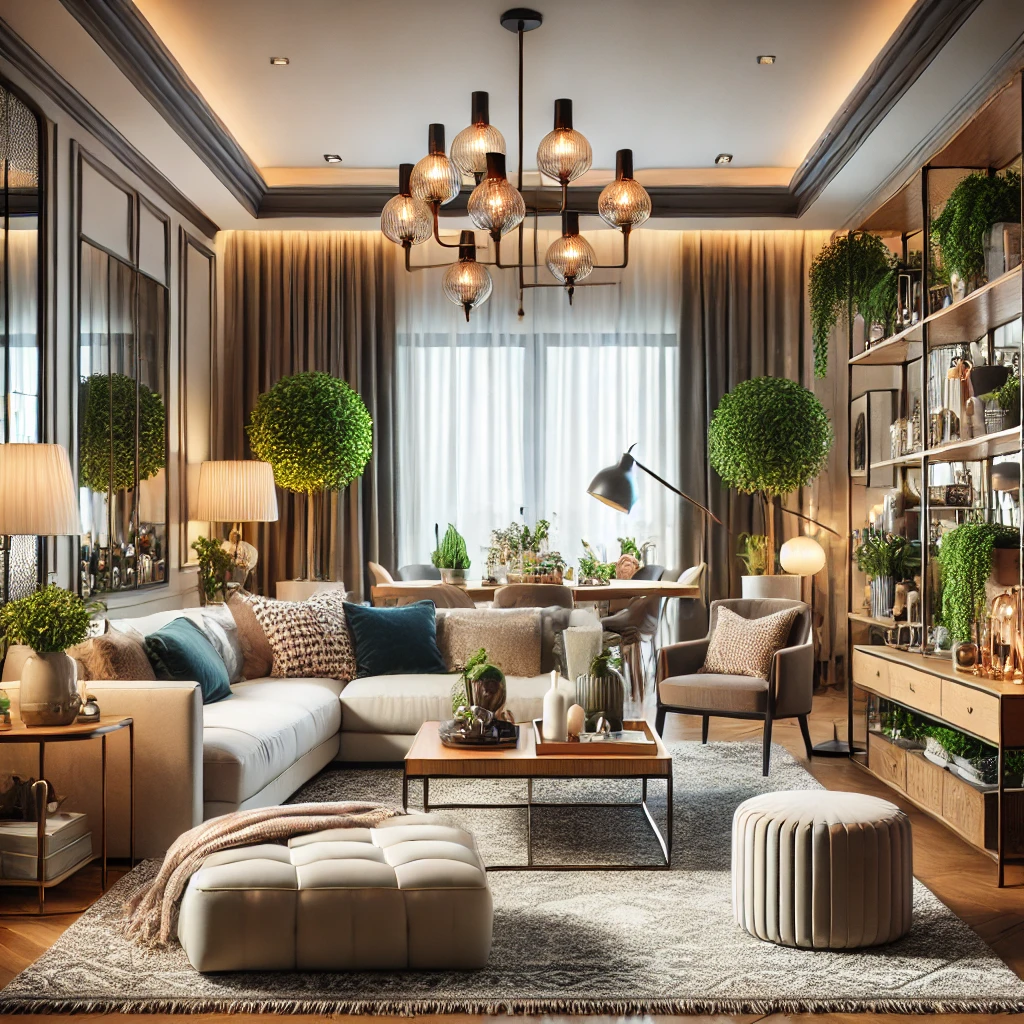
Living room designs play a crucial role in setting the tone and functionality of your space, blending style and comfort seamlessly.
Whether you prefer a modern, rustic, or eclectic look, the right living room designs can transform your home into a welcoming retreat.
By incorporating thoughtful layouts, balanced color schemes, and unique decor elements, you can create a space that reflects your personality while maximizing both aesthetics and practicality.
There are key design rules to follow and a few outdated ones you should break to truly make your space shine.
In this post, we’ll cover 10 essential living room design rules you should always follow and 3 outdated rules you should definitely break for a stylish, functional, and Pinterest-worthy space.
Let’s dive in!
10 Living Room Design Rules You Should Follow
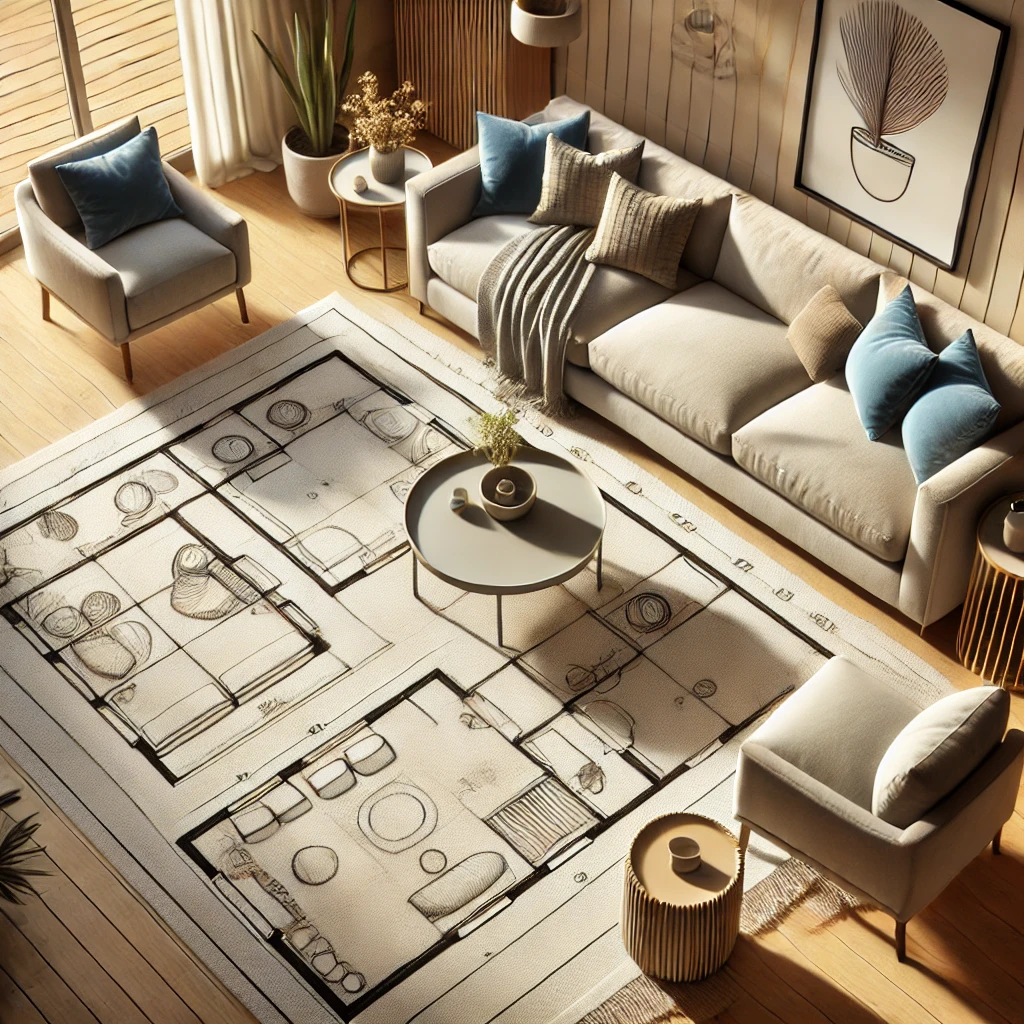
1. Always Start with a Layout Plan
Your living room design should start with a solid layout plan before you purchase furniture or décor.
A well-planned layout ensures smooth traffic flow, balanced furniture placement, and a functional space that suits your lifestyle.
How to Plan the Perfect Living Room Layout
✔️ Measure Your Space
Before buying anything, take accurate measurements of your living room, including walls, windows, doorways, and existing furniture.
✔️ Consider Your Lifestyle
- Do you entertain guests frequently? Opt for multiple seating areas.
- Love movie nights? A cozy sectional and a media console may be ideal.
- Have kids or pets? Durable materials and open space for play are essential.
✔️ Map Out Traffic Flow
- Leave at least 2.5 to 3 feet of walking space between furniture.
- Avoid blocking natural pathways from the entrance to other rooms.
✔️ Choose the Right Furniture Size
A common mistake in living room design is choosing furniture that’s either too big or too small.
Use painter’s tape on the floor to visualize furniture placement before making a purchase.
Pro Tip: Use design apps like Planner 5D or Roomstyler to create a digital layout before committing to furniture arrangements.
2. Choose a Focal Point
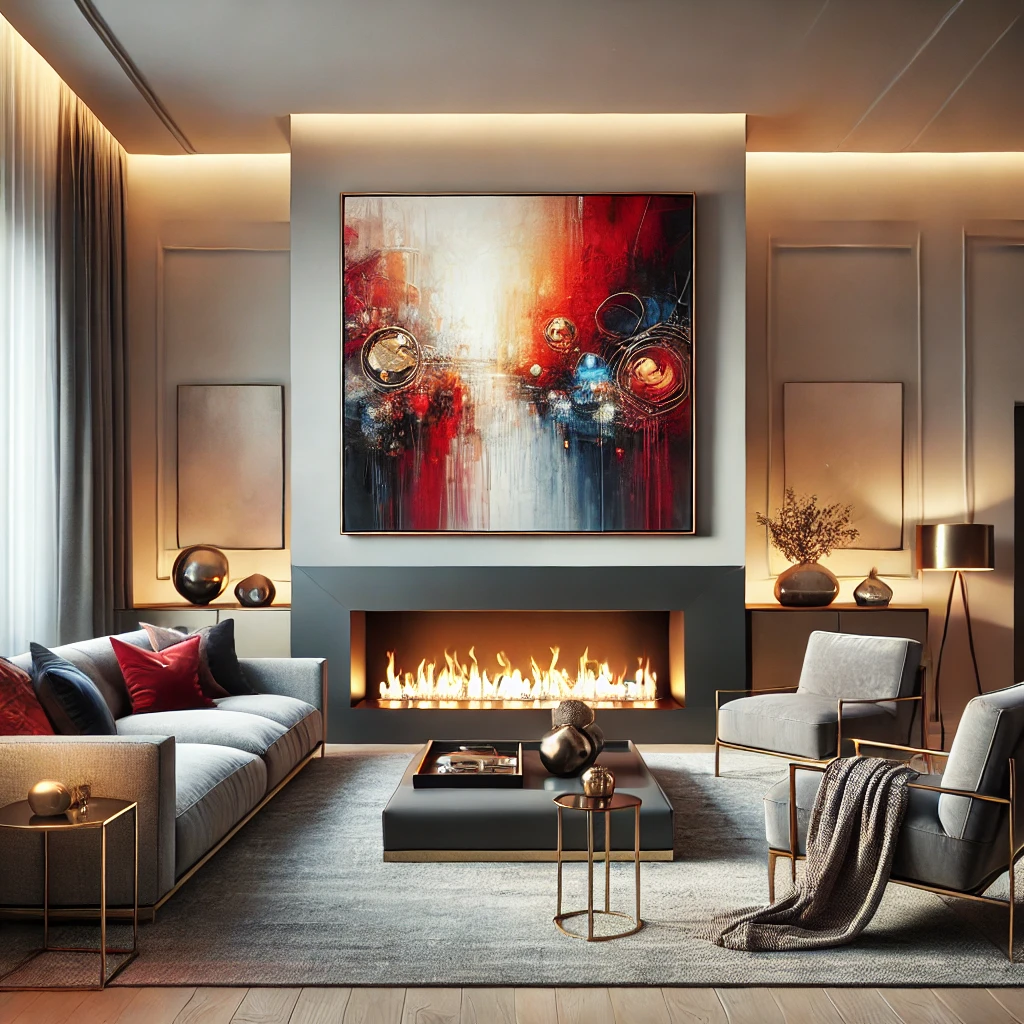
Every well-designed living room needs a focal point—a visually dominant feature that anchors the space and draws attention.
Without a focal point, a living room can feel scattered and unbalanced.
How to Create a Focal Point in Your Living Room
There are multiple ways to establish a focal point based on your style and needs:
✔️ Architectural Features
- A fireplace naturally becomes a stunning focal point. Enhance it with a statement mantelpiece or dramatic artwork above it.
- Large windows with a view serve as a beautiful and natural focal point—frame them with elegant curtains.
✔️ Statement Furniture
- A bold-colored sofa or uniquely shaped armchair can command attention.
- A grand coffee table with an eye-catching design can become the heart of the room.
✔️ Artwork & Accent Walls
- A gallery wall with framed photos, paintings, or art prints makes for an engaging focal point.
- Accent walls featuring textured wallpaper, wood panels, or a bold paint color add depth and character.
✔️ Media Centers & Bookshelves
- A stylish media console with floating shelves and decorative accents can integrate technology seamlessly.
- A floor-to-ceiling bookshelf filled with books, vases, and collectibles creates a sophisticated yet functional focal point.
Pro Tip: If you have multiple potential focal points (like a fireplace and TV), balance them by arranging furniture in a way that complements both.
3. Invest in a Statement Sofa
A statement sofa is arguably the most important piece of furniture in your living room design.
It sets the tone for the entire space and plays a major role in comfort, function, and aesthetics.
How to Choose the Perfect Statement Sofa
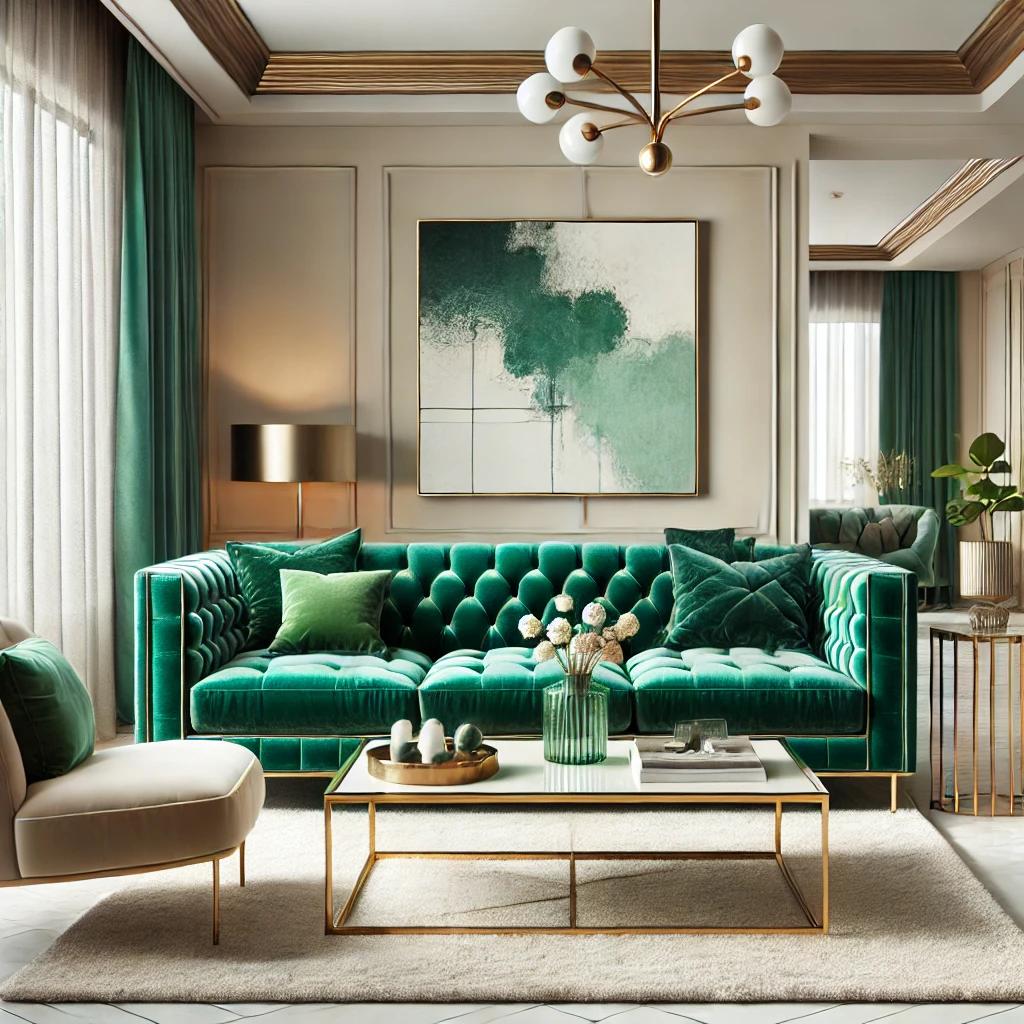
✔️ Size Matters
- For small living rooms, opt for a loveseat or compact sectional to maximize space without overwhelming the room.
- For large living rooms, a grand sectional or deep-seated sofa can create a cozy, inviting feel.
✔️ Pick the Right Material
- Leather: Timeless, durable, and easy to clean. Perfect for modern and industrial-style living rooms.
- Velvet: Luxurious and trendy, but requires more maintenance. Best for chic and elegant spaces.
- Performance Fabric: Ideal for families with kids and pets since it’s stain-resistant and long-lasting.
✔️ Consider Sofa Shape & Style
Your sofa should reflect your living room design style:
- Mid-Century Modern: Clean lines, tapered legs, and minimalist structure.
- Traditional: Plush, rolled arms, and ornate detailing.
- Contemporary: Sleek, streamlined, and neutral-colored.
- Boho/Scandinavian: Low-profile, natural fabrics, and cozy textures.
✔️ Choose a Color That Complements Your Space
- Neutral Shades (Beige, Gray, White): Versatile and easy to accessorize.
- Bold Colors (Emerald Green, Navy Blue, Mustard Yellow): Make a statement and add personality.
- Earth Tones (Terracotta, Olive Green, Rust): Warm and inviting, perfect for cozy aesthetics.
✔️ Comfort Is Key!
Test the depth, firmness, and overall comfort before purchasing. A beautiful sofa means nothing if it’s not comfortable for everyday use.
Pro Tip: If you’re unsure about committing to a bold-colored sofa, add color through throw pillows, blankets, and decorative accents instead.
4. Layer Your Lighting
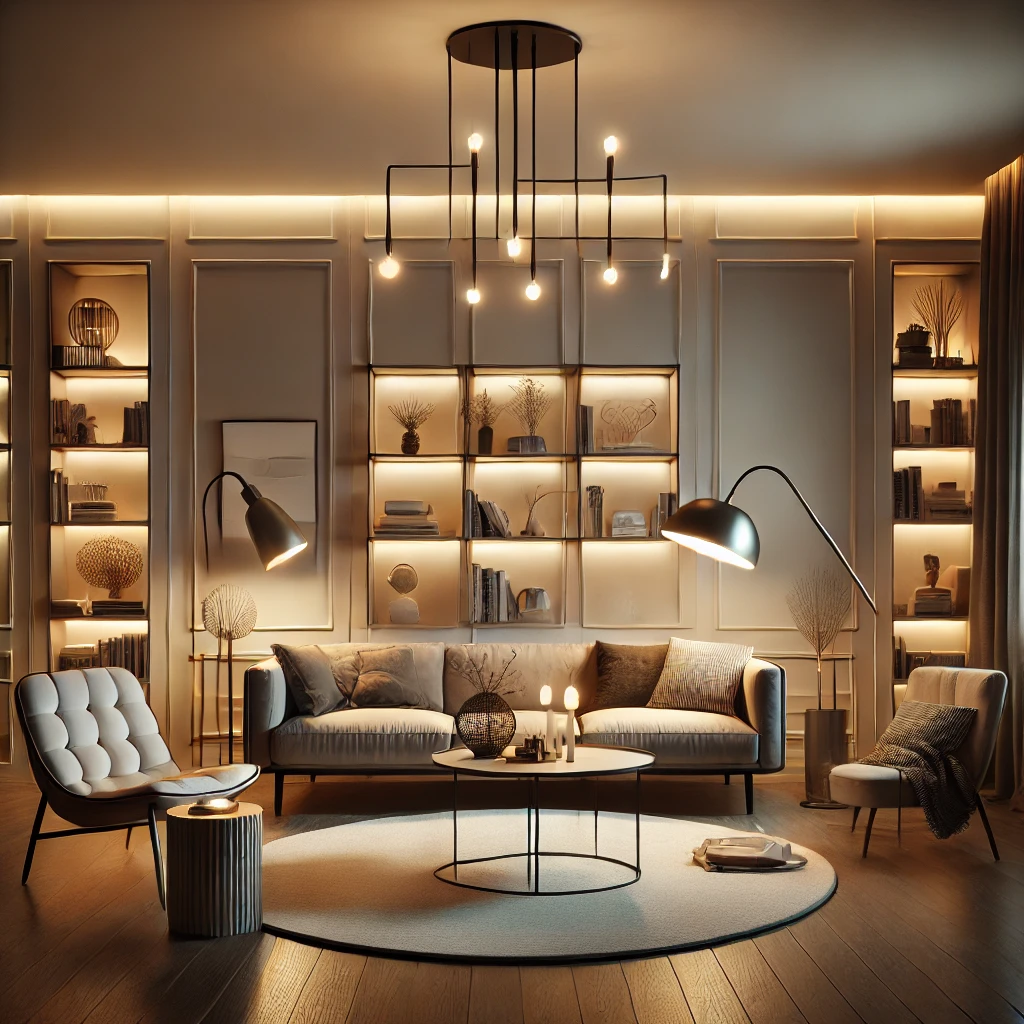
Lighting is one of the most crucial elements in living room design, yet it’s often overlooked.
A well-lit living room should have three layers of lighting: ambient, task, and accent.
Each layer serves a different function and contributes to the overall ambiance of your space.
The 3 Essential Layers of Lighting in a Living Room
✔️ Ambient Lighting (General Lighting)
This is the primary source of light in your living room design and sets the overall brightness of the space.
- Best Options: Ceiling-mounted fixtures, chandeliers, recessed lighting, or track lighting.
- Pro Tip: Choose dimmable lights to adjust the brightness based on the mood and time of day.
✔️ Task Lighting (Functional Lighting)
Task lighting provides direct, focused light for activities like reading, working, or knitting.
- Best Options: Table lamps, floor lamps, swing-arm wall sconces.
- Pro Tip: Position a floor lamp next to a reading nook or place table lamps on side tables for convenience.
✔️ Accent Lighting (Mood & Decorative Lighting)
Accent lighting highlights architectural features, artwork, or decorative elements, adding depth and warmth to your living room design.
- Best Options: Wall sconces, LED strip lighting, under-shelf lighting, and candles.
- Pro Tip: Use warm white bulbs (2700K–3000K) for a cozy and inviting atmosphere.
Lighting Mistakes to Avoid
🚫 Using Only One Light Source – A single overhead light makes a space look flat and uninviting.
🚫 Neglecting Dimmers – Dimmer switches allow you to control brightness and set the mood.
🚫 Ignoring Natural Light – Maximize daylight with sheer curtains or mirrors to reflect sunlight.
A well-lit living room is welcoming, cozy, and functional. By layering your lighting, you can create a versatile space that suits every occasion.
5. Use the 60-30-10 Color Rule

The 60-30-10 rule is a timeless color formula that interior designers use to create a balanced and visually appealing living room design.
This rule helps ensure your color palette is harmonious and not overwhelming.
How the 60-30-10 Color Rule Works
✔️ 60% – The Dominant Color
- The largest portion of your living room should feature the main color.
- This typically includes walls, large furniture pieces, and area rugs.
- Best Colors: Neutral tones like white, beige, gray, taupe, or soft pastels.
✔️ 30% – The Secondary Color
- This adds contrast and complements the dominant color.
- Found in curtains, accent chairs, decorative pillows, and smaller furniture pieces.
- Best Colors: A slightly bolder shade of the dominant color or a complementary hue.
✔️ 10% – The Accent Color
- This is the pop of color that makes your living room visually exciting.
- Found in throw pillows, artwork, vases, lamps, or a statement chair.
- Best Colors: Vibrant tones like mustard yellow, navy blue, emerald green, or burnt orange.
Examples of the 60-30-10 Rule in Action
✅ Modern Minimalist: 60% White, 30% Light Gray, 10% Black
✅ Boho Chic: 60% Beige, 30% Olive Green, 10% Rust Orange
✅ Cozy Traditional: 60% Taupe, 30% Deep Blue, 10% Gold
Color Mistakes to Avoid
🚫 Using Too Many Colors: Stick to a maximum of 3-4 shades to maintain a cohesive look.
🚫 Ignoring Undertones: Warm colors (reds, yellows) and cool colors (blues, greens) should complement each other.
🚫 Forgetting Textures: Layering colors with different textures (wood, velvet, metal) makes a space feel dynamic.
Using the 60-30-10 rule ensures your living room design feels intentional and aesthetically pleasing.
6. Incorporate Texture for Depth
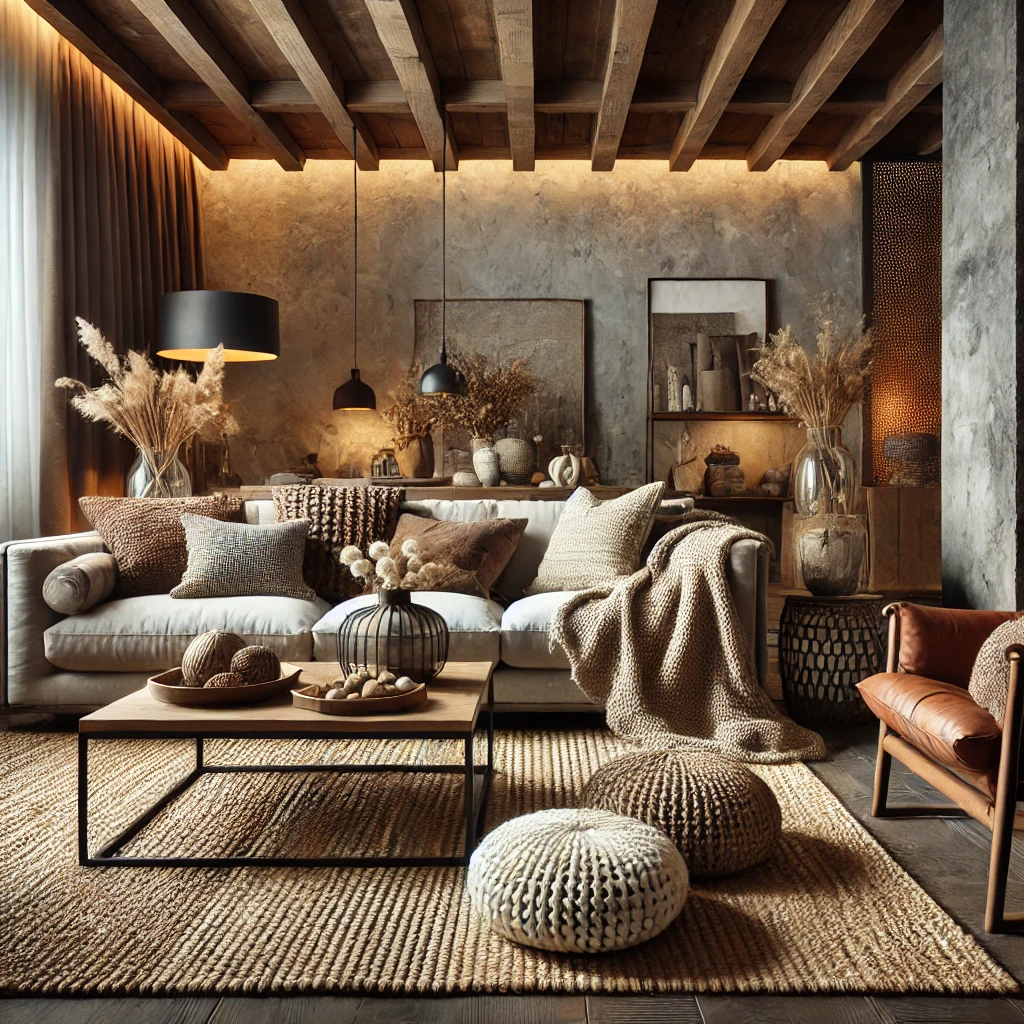
Texture is the secret weapon of interior designers! A room with varied textures feels rich, inviting, and visually interesting.
Even if you use a neutral color palette, adding texture will prevent your living room design from looking flat or boring.
How to Add Texture to Your Living Room Design
✔️ Mix Different Materials
- Combine soft fabrics (velvet, wool, faux fur) with hard surfaces (wood, metal, glass) for contrast.
- Example: A leather sofa with a plush throw blanket and a wooden coffee table creates depth.
✔️ Layer Rugs & Upholstery
- A jute or woven rug under a softer wool or shag rug adds dimension.
- Consider textured upholstery like linen sofas or boucle chairs for added interest.
✔️ Incorporate Natural Elements
- Use wooden coffee tables, stone vases, or woven baskets to bring an organic touch.
- Houseplants not only add texture but also make the space feel fresh and lively.
✔️ Play with Patterns
- Introduce striped, floral, or geometric patterns through accent pillows, curtains, or wallpaper.
- Mixing different patterns in the same color palette keeps things visually appealing.
✔️ Use Wall Treatments for Depth
- Consider shiplap, exposed brick, or paneled walls to add architectural texture.
- Wallpaper with raised detailing or fabric finishes enhances depth.
Texture Mistakes to Avoid
🚫 Sticking to One Material: A room full of smooth or hard surfaces (like all leather or all wood) can feel cold and sterile.
🚫 Overloading with Texture: Too many contrasting textures can make a room feel chaotic—balance is key!
🚫 Ignoring Soft Touches: Add plush elements like throws, area rugs, or cushioned furniture for warmth.
Adding texture is a simple yet powerful way to elevate your living room design and make it feel cozier and more refined.
7. Anchor Your Space with a Large Rug
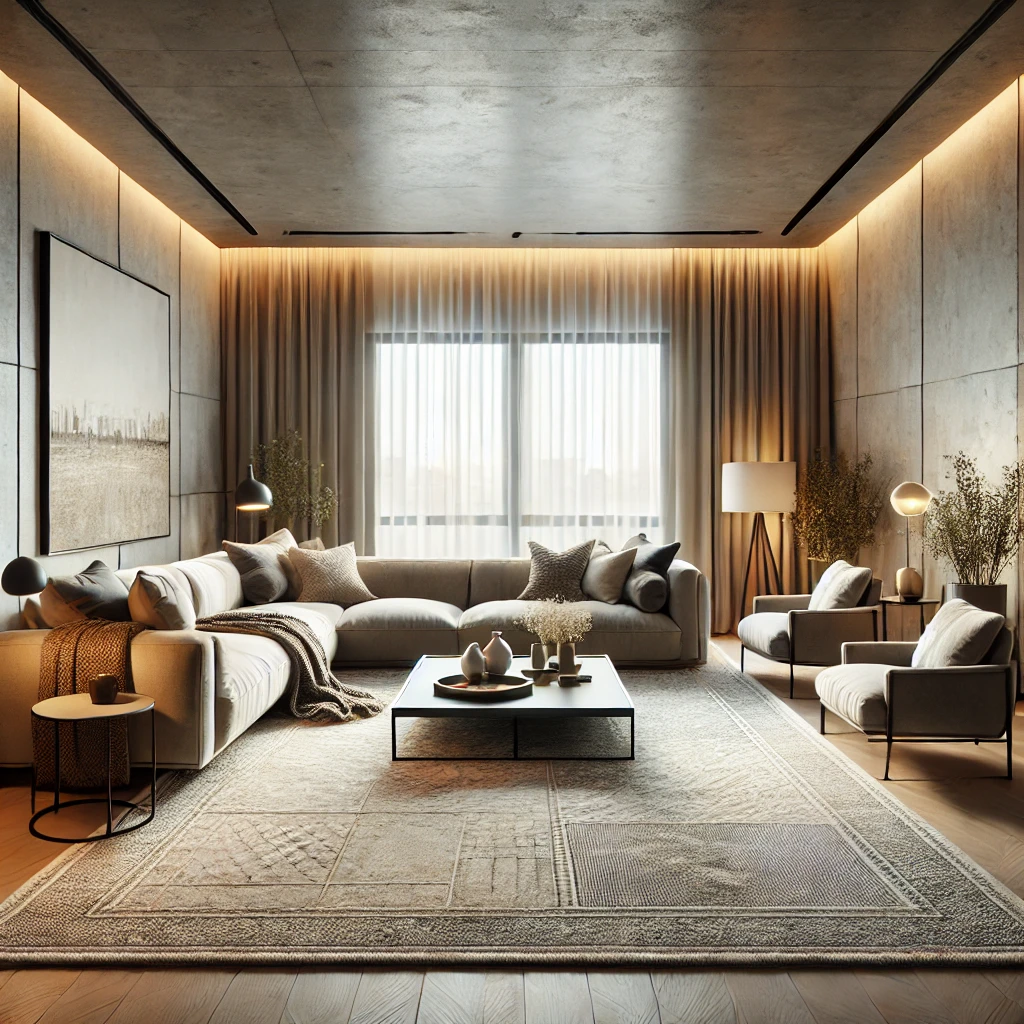
A well-chosen area rug can instantly define your living room design, making it feel more polished and cohesive.
However, one of the biggest mistakes people make is choosing a rug that’s too small, which makes the space feel disconnected.
How to Choose the Right Rug Size for Your Living Room
✔️ Standard Rug Sizes & Placement Tips:
- 5′ x 8′ Rug: Best for small living rooms; place it under the coffee table only.
- 8′ x 10′ Rug: Works for medium-sized living rooms; front legs of furniture should rest on the rug.
- 9′ x 12′ or Larger: Perfect for spacious living rooms; ensures all furniture sits comfortably on the rug.
✔️ Proper Rug Placement for a Balanced Look:
- Front Legs on the Rug: This is the most common placement for a balanced, cohesive look.
- All Legs on the Rug: Creates a unified space and works well in open-concept homes.
- No Legs on the Rug: Best for layering smaller rugs over carpet or hard flooring.
Best Rug Materials for Your Living Room
- Wool: Durable, soft, and naturally stain-resistant.
- Jute/Sisal: Adds texture and an organic touch but can be rough underfoot.
- Cotton: Lightweight and easy to clean, ideal for casual spaces.
- Synthetic (Polyester, Nylon, or Polypropylene): Budget-friendly and great for high-traffic areas.
Rug Mistakes to Avoid
🚫 Choosing a Rug That’s Too Small: A tiny rug makes a living room feel disjointed.
🚫 Ignoring the Shape of the Room: A rectangular rug in a square room may look awkward—consider a round or square rug instead.
🚫 Not Using a Rug Pad: A rug pad prevents slipping, protects flooring, and adds comfort underfoot.
A properly sized rug grounds your living room design, making it feel warm, inviting, and well put together.
8. Add Greenery for a Fresh Touch
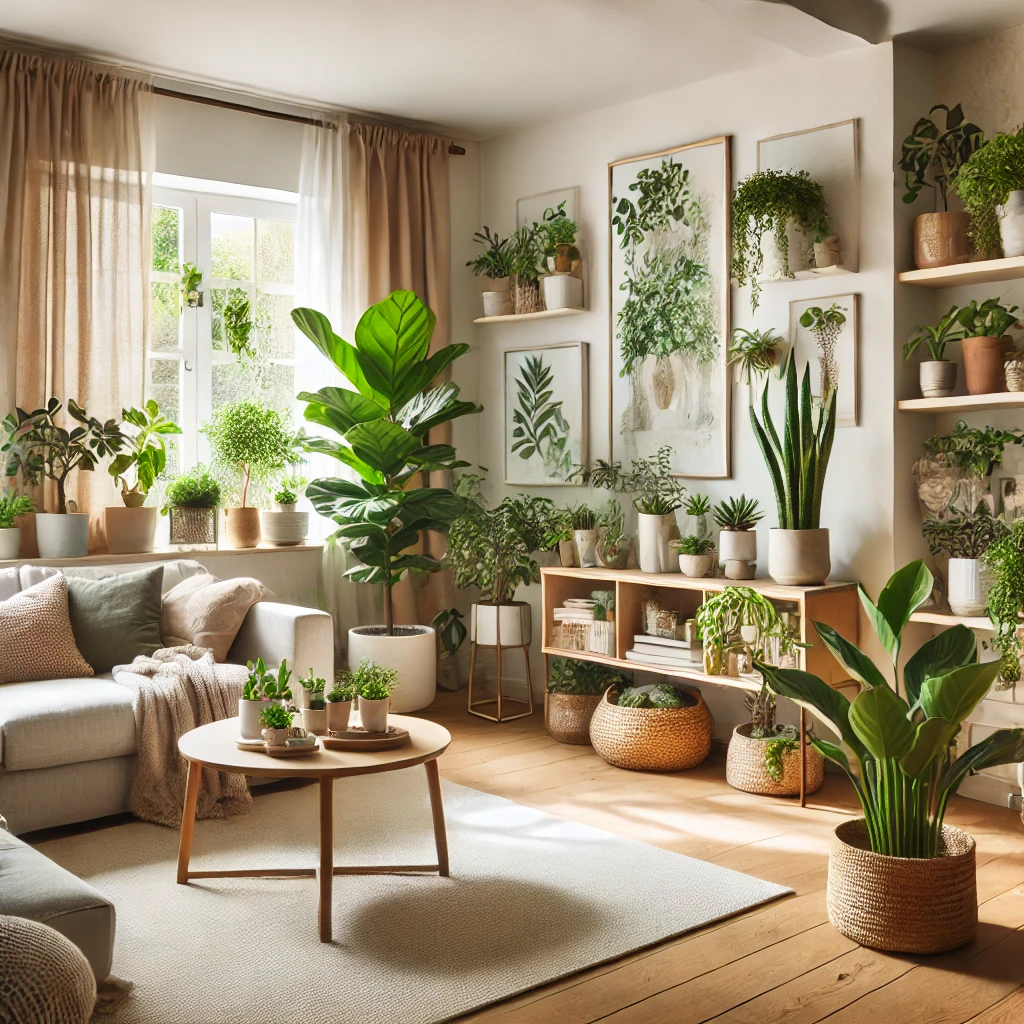
Adding plants and greenery is one of the easiest ways to breathe life into your living room design.
Not only do they add color and texture, but they also improve air quality and create a calming atmosphere.
Best Plants for Your Living Room
✔️ Low-Maintenance Plants:
- Snake Plant: Virtually indestructible and thrives in low light.
- ZZ Plant: Requires minimal care and can survive with little water.
- Pothos: Grows quickly, easy to maintain, and looks great in hanging planters.
✔️ Statement Plants for a Bold Look:
- Fiddle Leaf Fig: A trendy choice that adds height and elegance.
- Bird of Paradise: Large tropical leaves create a dramatic effect.
- Rubber Plant: Stylish, glossy leaves make it a great focal point.
✔️ Small Plants for Shelves & Coffee Tables:
- Succulents: Require minimal watering and come in fun shapes.
- Air Plants: No soil needed—just occasional misting.
- Herbs (Basil, Mint, Rosemary): Functional and fragrant for a fresh touch.
How to Style Plants in Your Living Room
🌿 Place large plants in corners to add height and dimension.
🌿 Use hanging planters for a boho, space-saving touch.
🌿 Group small plants in decorative pots on coffee tables or bookshelves.
Plant Mistakes to Avoid
🚫 Overwatering: Most indoor plants prefer dry soil between waterings.
🚫 Ignoring Light Requirements: Some plants need bright, indirect light, while others thrive in shade.
🚫 Cluttering the Space: Too many plants can make your living room feel overcrowded—stick to a few key pieces.
Adding greenery enhances your living room design, making it feel fresh, lively, and more connected to nature.
9. Use Mirrors to Make the Room Feel Bigger
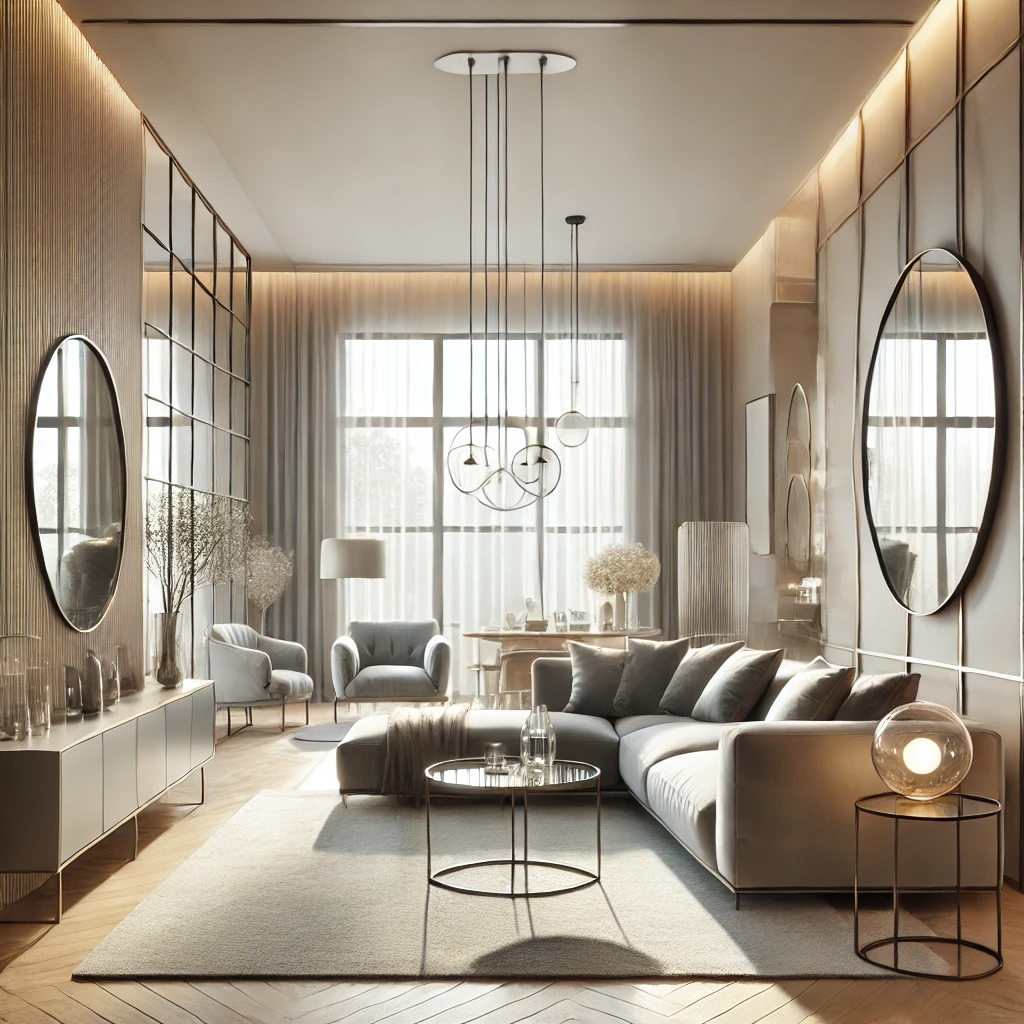
Mirrors are a secret weapon in interior design, especially for small living rooms.
They reflect light, create depth, and make a space appear larger and brighter.
Where to Place Mirrors for Maximum Impact
✔️ Across from a Window: Reflects natural light, making the room feel airy.
✔️ Above a Fireplace or Console Table: Acts as a stylish focal point.
✔️ On a Gallery Wall: Mix mirrors with framed art for added depth.
✔️ Behind a Sofa: Creates the illusion of more space.
✔️ Floor-Length Mirror in a Corner: Expands the room visually and adds elegance.
Mirror Styles to Match Your Living Room Design
- Round Mirrors: Soften a space and add a modern touch.
- Oversized Rectangular Mirrors: Make a bold statement and maximize light.
- Antique or Vintage Mirrors: Add character and charm.
- Frameless Mirrors: Minimalist and sleek for a contemporary look.
Mirror Mistakes to Avoid
🚫 Placing a Mirror Where It Reflects Clutter: It will double the mess!
🚫 Using a Tiny Mirror in a Large Space: Opt for bigger mirrors to maximize the effect.
🚫 Ignoring the Frame Style: Choose a frame that complements your overall decor.
By strategically placing mirrors, you can transform your living room design, making it feel brighter, more open, and elegant.
10. Keep Clutter Under Control with Smart Storage
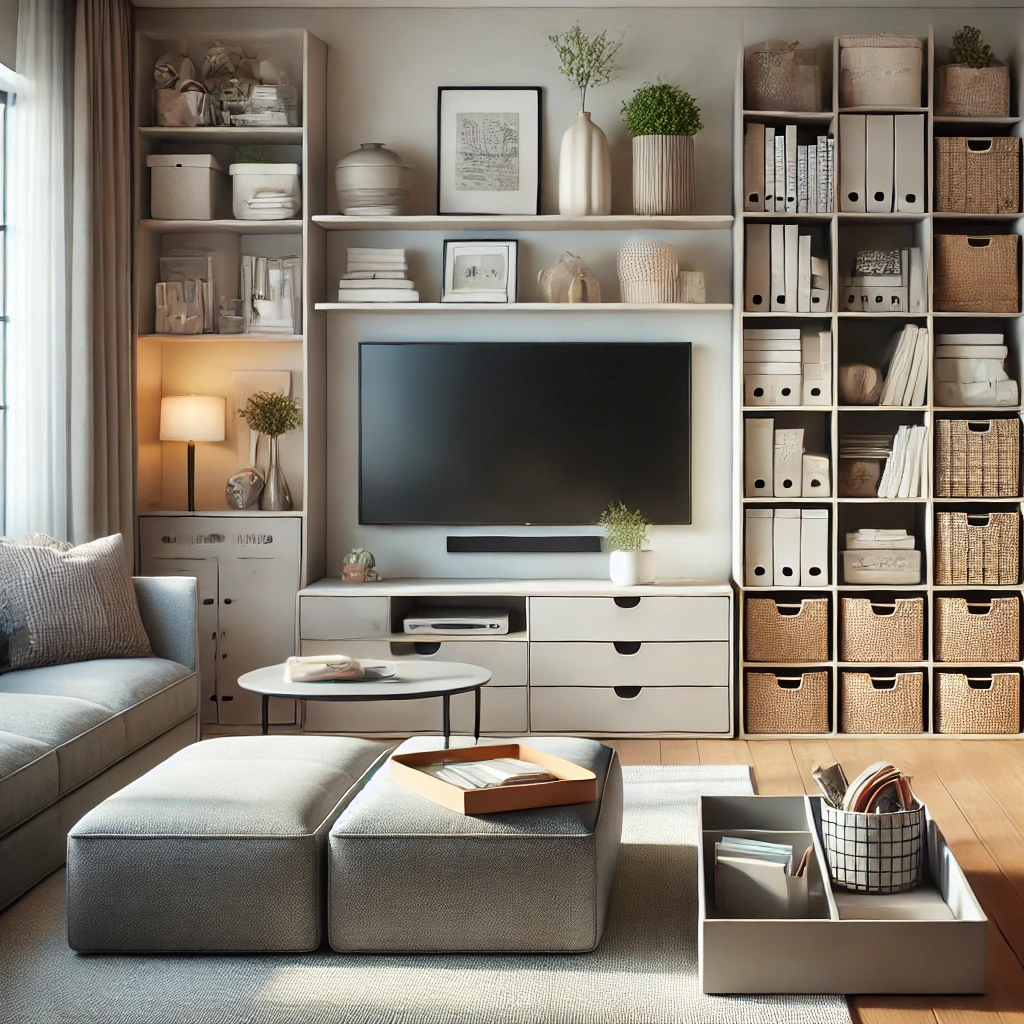
A clutter-free living room design feels calm, spacious, and organized.
Smart storage solutions ensure that everything has its place, keeping your space both functional and stylish.
Smart Storage Ideas for a Tidy Living Room
✔️ Multi-Functional Furniture:
- Storage Ottomans: Perfect for stashing blankets, remotes, and magazines.
- Coffee Tables with Hidden Storage: Keep clutter out of sight.
- Sofas with Built-In Storage: Ideal for small living rooms.
✔️ Wall-Mounted Storage:
- Floating Shelves: Display books, art, and decorative pieces without taking up floor space.
- Built-In Cabinets: Custom built-ins provide ample storage while looking stylish.
- Hanging Baskets or Wall Organizers: Perfect for small accessories.
✔️ Decluttering Strategies:
- The One-Year Rule: If you haven’t used it in a year, donate or toss it.
- Baskets & Bins: Use labeled bins for easy organization.
- Minimalist Approach: Keep only decor that adds value and joy.
Storage Mistakes to Avoid
🚫 Overstuffing Shelves: Keep display areas tidy with a mix of books, art, and decor.
🚫 Using Only Closed Storage: Open shelving adds visual interest and keeps essentials accessible.
🚫 Ignoring Vertical Space: Use wall-mounted storage to free up floor space.
A well-organized living room design makes your home feel clean, inviting, and stress-free while maximizing every inch of space.
With the right rug size, greenery, mirrors, and smart storage solutions, your living room design will feel intentional, stylish, and highly functional.
These elements work together to create a space that is both beautiful and practical.
3 Living Room Design Rules You Should Break (And What to Do Instead!)
Design rules exist for a reason, but some are outdated and limit creativity. If you want a living room design that feels unique, stylish, and personal, it’s time to break these three outdated rules and embrace a fresh approach!
1. Matching Furniture Sets Are a Must (Break It!)
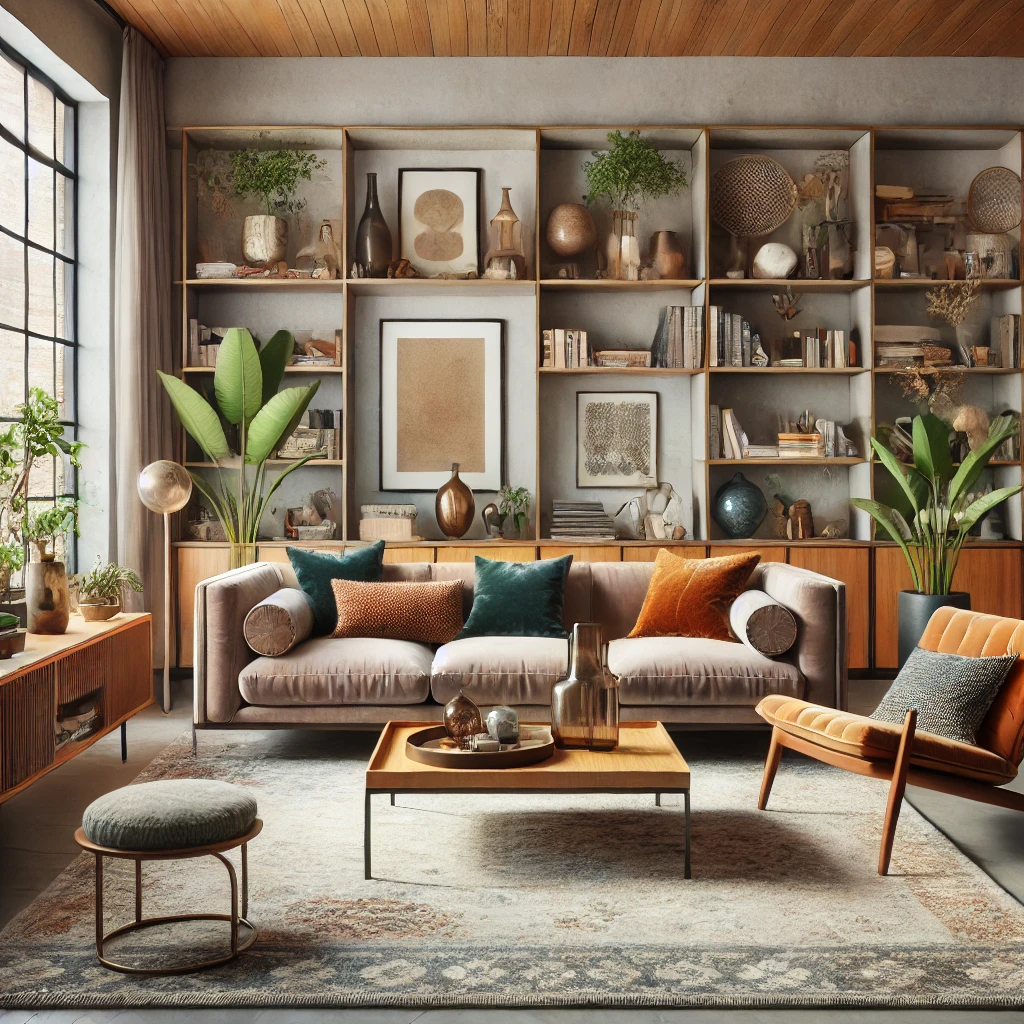
In the past, furniture showrooms and home magazines pushed the idea that a “perfect” living room meant matching sofas, chairs, coffee tables, and side tables.
While this approach creates a cohesive look, it often results in a boring, uninspired space that lacks personality.
Why Matching Furniture Sets Feel Outdated
🚫 They make your space look like a catalog, rather than a home.
🚫 They lack individuality and character.
🚫 They can feel overly formal and stiff instead of warm and inviting.
Better Alternative: Mix & Match for a Curated Look
Instead of buying a full matching furniture set, mix different styles, colors, and materials to create a layered, lived-in feel.
✔ Pair a sleek modern sofa with a vintage or reclaimed wood coffee table to create a contrast between contemporary and rustic elements.
✔ Use different fabrics for your seating—for example, combine a velvet couch with leather or woven accent chairs.
✔ Experiment with mixed finishes—like metal legs on a coffee table with a wood-finished bookshelf.
✔ Vary your furniture styles—for instance, a mid-century modern couch paired with a boho-style rattan chair.
Pro Tip: Stick to a unifying color palette (such as warm neutrals or earthy tones) to ensure your mixed pieces still feel cohesive.
✅ The result? A living room that looks curated over time, full of charm and personality!
2. Your TV Must Be the Focal Point (Break It!)

For decades, TV-centered living rooms have dominated home layouts.
While it’s true that many people enjoy watching movies, sports, or shows, designing your entire space around the television limits creativity and can make the room feel less inviting.
Why the TV Shouldn’t Always Be the Star
🚫 It can dominate the space, making the room feel cold or unbalanced.
🚫 It can disrupt the aesthetics if it’s the only dark, blank surface in the room.
🚫 It discourages other forms of interaction, like conversation or reading.
Better Alternative: Create a More Dynamic Focal Point
Instead of making the TV the main attraction, try integrating it subtly into the design or shifting focus to another key feature.
✔ Mount the TV on a side wall rather than placing it front and center.
✔ Blend the TV into a gallery wall with framed artwork, mirrors, or decorative elements.
✔ Use a media console with shelving that allows the TV to blend in among books, plants, and décor.
✔ Incorporate a statement fireplace, a large piece of art, or a dramatic accent wall as the focal point instead.
✔ Try a Frame TV that displays digital art when not in use, making it look like part of your decor rather than a big black screen.
Pro Tip: If you still want the TV to be practical but less dominant, try a swivel wall mount so you can angle it for viewing when needed, then tuck it away.
✅ The result? A balanced, inviting living room where the focus is on style and comfort, not just screen time.
3. Stick to One Design Style (Break It!)
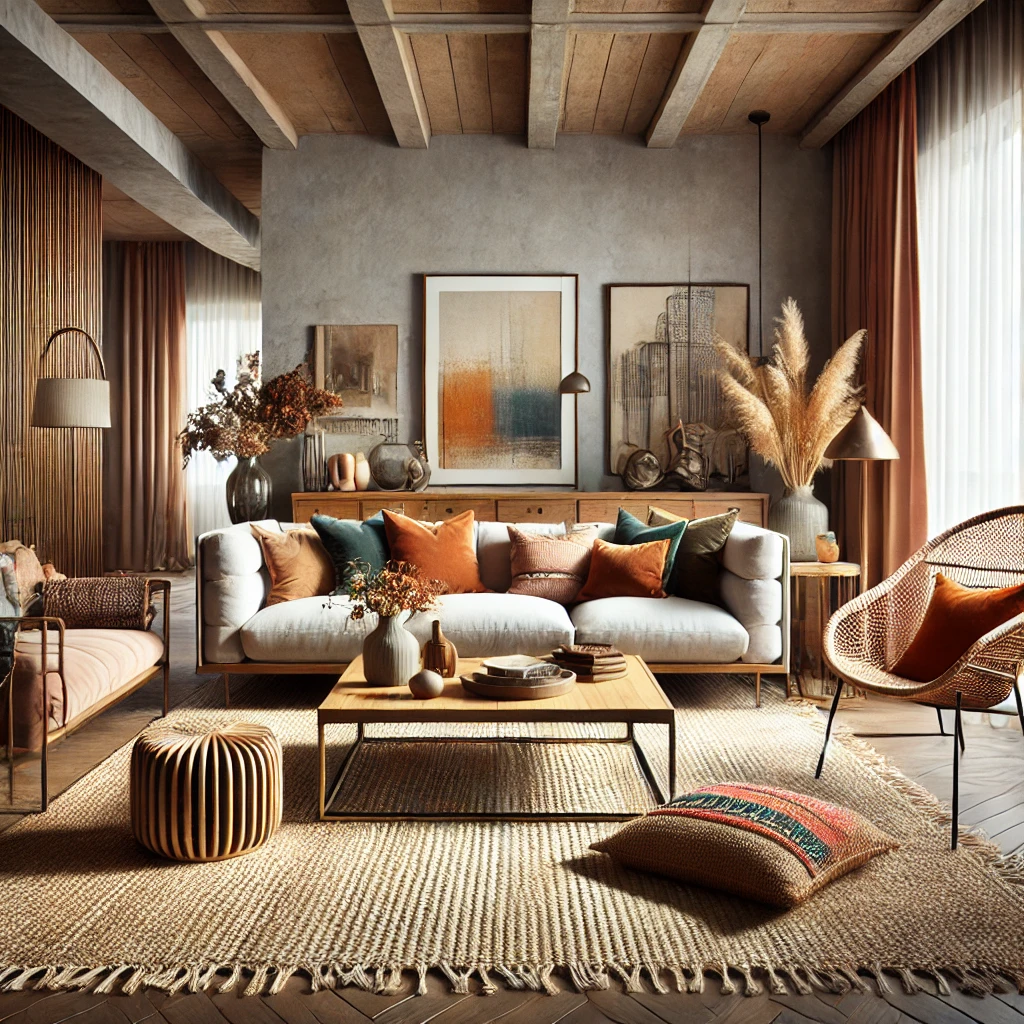
Another outdated rule is that you must stick to one design style—whether it’s modern, boho, Scandinavian, industrial, farmhouse, or traditional.
While cohesive design is important, limiting yourself to a single style can make your space feel predictable and one-dimensional.
Why a Single-Style Living Room Feels Too Staged
🚫 It can lack depth and originality.
🚫 It may feel like a showroom rather than a personalized space.
🚫 It can become outdated quickly if a trend fades.
Better Alternative: Blend Styles for a Unique & Dynamic Space
Instead of committing to one rigid aesthetic, embrace an intentional mix of styles that reflect your personality.
✔ Modern + Rustic: Combine sleek furniture with raw materials like reclaimed wood and stone.
✔ Boho + Minimal: Use neutral colors and simple furniture but add layered textures like woven rugs and macrame.
✔ Scandinavian + Industrial: Pair soft, light woods with exposed metal or brick for a balance of cozy and edgy.
✔ Traditional + Contemporary: Use classic, elegant pieces alongside bold, modern accents for a refined yet fresh look.
How to Mix Styles Without Clashing
💡 Choose a common element—such as a specific color scheme, texture, or material—to tie everything together.
💡 Balance the ratio—stick to about 70% of one style and 30% of another for a harmonious look.
💡 Use transitional pieces—like a mid-century modern chair in a farmhouse setting or industrial lighting in a minimalist room.
Pro Tip: Don’t be afraid to play around with different textures and materials—it’s what makes a space feel layered and inviting!
✅ The result? A unique, Pinterest-worthy living room that feels personalized rather than mass-produced.
Rethinking Living Room Design Rules
Interior design should be about expressing your personal style rather than following outdated rules.
By breaking these three design rules, you’ll create a living room that feels more inviting, stylish, and uniquely yours.
🚀 Forget the “matchy-matchy” sets and mix furniture for a curated look.
🚀 Ditch the TV-centric layout and focus on creating a warm, interactive space.
🚀 Blend different styles to create a home that truly reflects your personality.
Which design rule are you excited to break first?
Let me know in the comments! 🎉
Related Posts:
Boys Bedroom Ideas for Tiny Spaces – 10 Smart Design Tricks!


